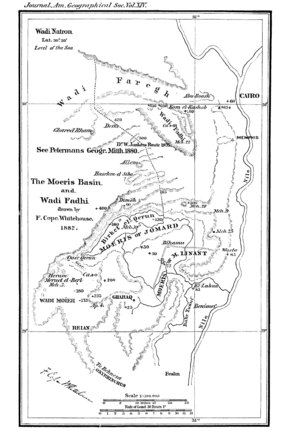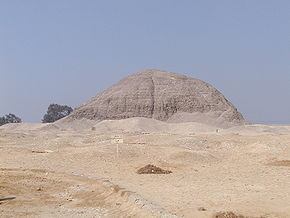Moeris
Moeris or Meris is the name given by ancient Greek writers to a large lake in the present-day region of El Fayun, Egypt, whose waters were regulated in the 17th century. XIX B.C. C. under the reign of Amenemhat III, pharaoh of the Middle Kingdom. Today it is a much smaller salt lake called Birket Qarun.
Etymology
The name given by the ancient Egyptians was mer-uer, "the great lake". It also received other names, such as: "the lake of Osiris", "the pure lake" or "the Lake". Herodotus, who visited it in the 5th century B.C. C., called it Meris. The current name of the region: El Fayún, means "the Sea", recalling old denominations.
History
Although the region was already populated in prehistoric times, it was during the Middle Kingdom when the region was systematically colonized, becoming one of the most fertile areas on earth when the great canalization works were undertaken during the XII dynasty allowed to create an immense arable surface.
The area surrounding the lake was made up of swampy land, and to transform it into arable land it was necessary to drain it and regulate the flow of water from the Nile, and that was the great achievement of the Amenemhat III technicians, who carried out a gigantic channel network that caused the astonishment of the ancient world. Herodotus describes it thus:
But even though it is the maze work so rich and great, it causes even greater admiration the lagoon that they call Meris, near which he built. It counts the circumference lagoon 3,000 stadiums, a measure that corresponds to sixty schenos, the same as they have, in length the sea coasts of Egypt; it runs along the North to the Midday, and has fifty orgies of background in its greater depth. It itself states that it is the work of hands and artificial.Being the land in the whole region so arid and lacking of water, it cannot be born in the same lagoon, but it has been driven by a channel derived from the Nile; and in fact, it passes from the river to the lagoon for six months, in which the fish resonates to the Fisco twenty mines daily, and leaves the lagoon in the other six months, which produces a talent of silver every day.
(...)Heroscope
Amenemhat III also erected near the lake an immense complex of buildings and a large necropolis, abandoning the one at Dahshur. Herodotus, who visited the place, called it "The Labyrinth", due to the magnitude and complexity of the complex. The Egyptians of posterity, to honor his memory, revered him as a god until the end of Ancient Egyptian history.
...and, therefore, with such union, they agreed to leave a monument in the common name of all, and with this object they built the labyrinth, something beyond the Meris Lagoon, to the city called the Crocodiles. I wanted to see it for myself, and it seemed even greater than it used to be said and urged. I will dare to say that anyone who travels the fortresses, walls and other factories of the Greeks, who boast of their greatness, no one will find among all that is not lower and lower in coast and at work to that labyrinth.Heroscope
The great humidity of the place and the destructive action of man, only left remains of the pyramid erected by Amenemhat, but almost nothing remained of the "Labyrinth" that astonished Herodotus so much.
| mer-uer (Moeris) in hieroglyphic |
|
Contenido relacionado
Geography of the Democratic Republic of the Congo
Pleistocene
VII millennium BC c.

